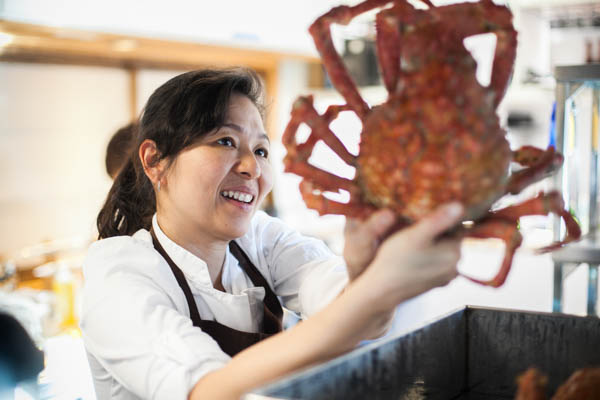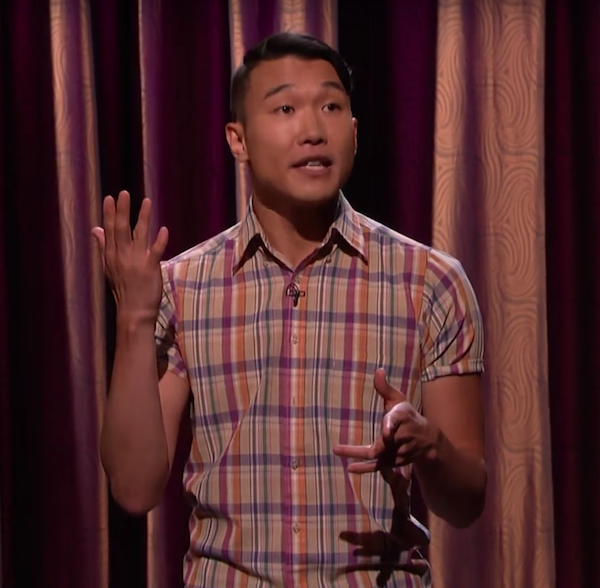It’s been five years since Niki Nakayama launched her kaiseki revolution with n/naka, the West Los Angeles-based restaurant that not only shook up Southern California’s growing culinary scene, but let the entire world know that this bad-ass female chef was going to do the butt-kicking. Since then, she’s continued to refine her impeccable skills in the kitchen by rethinking what kaiseki is (and can be), settled down with (and is working alongside) her partner/sous-chef, Carole Iida and has been featured in Netflix’s recent mind-bending documentary “Chef’s Table” (queue it up tonight if you haven’t seen it yet). But despite her increasing fame as a culinary master, Niki remains truly humble for all the praise and continues to work hard toward making the dining experience at n/naka an unforgettable one.

Kore Asian Media: What is kaiseki?
Niki Nakayama: Kaiseki is the most formal way of dining in Japan. It’s a dinner made up of multiple courses, and the idea behind it is to showcase which ingredients are in season and are local, and finding the best technique to present them. My personal take is to have our guests experience kaiseki in a way that makes sense because we’re in California. When they’re here, I want them to know they’re not in Japan, they’re in Los Angeles…this is California.
KAM: How does n/naka redefine what kaiseki is?
NN: We launched a special menu called “California,” which is something very near and dear to my heart. I came up with the concept after visiting Japan, and the most common response to my questions about food were always: It’s important to find ingredients that are closest (local) to you. There’s nothing as fresh or more representative than that of where you’re at. Most of the ingredients we’ve used are brought in from Japan — we’re not looking into our “home” enough, so I adjusted my menu accordingly. It was challenging but also the most exciting part of the process. There are so many things that you’d never think existed, some very similar and also very different from Japan.
I met a famous local forager, Pascal Baudar, who recommended all these things to try, and as a group, we began to learn about things that are naturally here, which was the first step. The biggest part was the seafood, especially for our restaurant, and I was lucky enough to get on board with a program called “Dock To Dish,”, which is a CSA food program that brings you seafood every week — you don’t know what you’re getting but it’s all from California waters, which is really interesting. I also met a really great Japanese fisherman who taught me what to do with technique after the fish has been caught, which is called ikejime (a means of paralyzing fish to maintain the quality of its meat), which then allows non-traditional fish to be edible as sushi and sashimi.
KAM: In culinary school, they always teach you rules of plating to go by. Do you still work with that in mind or do you go completely organic with your own style?
NN: I totally work organically while keeping in mind things like non-edible garnishes. But in Japanese cuisine there are a lot of non-edible garnishes because they’re often representative of seasons. It’s a visual way of joining nature to food, a reminder of where we’re at. I like those old traditional things about Japanese cooking and the creative process of putting things together because it is organic. There’s no ego involved [when you’re working like this] since you’re so connected to the food. And that sense of connection is so far beyond what it actually is. I’ve been building my menu my entire career, which is a culmination of everything I’ve learned. Even dishes that have been around since the very beginning until now. I don’t write down recipes—I want [my dishes] to evolve as we evolve. It can’t be the exact same thing even though my guests can’t see or taste the difference.

KAM: How does n/naka strive to make the customer experience better?
NN: When I first opened n/naka, I thought, “Oh, if I make good food, that’s good enough.” Great food is expected, but to craft an entire experience from the moment a guest makes a reservation to the final bite, taking that whole thing into consideration is what differentiates what we’re doing from other restaurants. Since we’re already omakase, where I choose the food for the diner, when people come back it’s my responsibility to offer an experience that’s different from the one they had before. Part of the enjoyment of not knowing what you’re going to get is that element of surprise. When you come back and you’re still able to be surprised, that means we did our job.
Carole Iida: People don’t eat food like this simply for the food anymore. You can get a great $5 meal almost anywhere now—it may not have much of an experience as it’s nourishment. When people come here, they want an event. Part of that involves making our servers aware that it’s not “just dinner” but showing guests what hospitality really means. Because we’re Japanese, that level of hospitality should make them feel like they’re the most special guest that evening, regardless of who they are or if they’re a repeat diner. We all have this human need to feel special when we’re out enjoying ourselves with friends and family, and if we’re able to communicate the warmth and heart that goes into the food we prepare and the service that goes with it, to me that’s the ideal service night. We want your service to feel real and for you to feel special.
KAM: Carole, how do you support Niki in her role as her sous-chef? Is n/naka as much your baby as it is hers?
CI: Very much so, but in terms of being a chef, I’m not the culinary genius she is. I come from a family with a long history of being in the restaurant industry, so I love food and I’ve always been around cooking. It’s a great partnership because of what she has to do outside of the restaurant now, like media and events. Someone has to keep things organized and running smoothly here, which is my forte. I’m much more of a structured chef with things needing to be in its right place, and helping to keep our staff stay on track. If I were more driven in that creative sense and to be a chef of that level, we might butt heads more often but it works out well since we talk about ideas. I get a lot of my inspiration from being around her and seeing what she comes up with. It’s been a huge learning experience since I come from a much simpler cooking background.

KAM: How did you end up as her sous-chef?
CI: It was a very lucky chance—we had just started dating, and she had lost her sous-chef after nine years. I could tell she was super stressed about what to do because she felt responsible to those guests who were showing up through word of mouth. I wasn’t sure how helpful I would be but I thought at least I could wash rice and make dashi, the menial tasks. I felt the pressure for her and we were both unsure since it was so early on—but it was necessary at the time and she gave me the opportunity, which wound up becoming a perfect fit. I could take care of all the little things while she focused on the creative aspect. Since then I’ve learned more about plating and what makes a n/naka dish so special.

KAM: Ok, let’s switch to some fun topics: What’s your favorite Japanese comfort food to make when you’re at home, nothing fancy.
NN: That’s an easy one: shabu shabu. Or even sukiyaki—we got this recipe from a friend of ours, which uses basil and garlic. In the beginning it tastes like more traditional sukiyaki, then at the end we add tomato sauce and it turns into a completely different dish. Comfort dishes are always one pot, something to share with family.
KAM: Favorite drive-thru food?
NN: In N Out … and I order mine with raw and cooked onions, without the spread and substitute that with ketchup and mustard.
CI: Tacos. We haven’t found our spot yet, like the one we went to back when we lived in the SGV (San Gabriel Valley). Most of the time we wind up buying sandwiches.
KAM: Carole, are you from the SGV too?
CI: Arcadia. But funny thing is we never knew each other growing up. She used to eat at my parents’ restaurant, and my dad had been to the little deli she ran with her sister — that’s when I first heard about Niki. It wasn’t until years later when I realized “You’re that person everyone in Arcadia was talking about.” It’s pretty crazy when we think about it—turns out not only were we both from the 626 [area code] but we actually lived five minutes apart! It got weirder when we also discovered our family dogs were both named Sammy (laughs). Maybe it was the universe trying to tell us something.
KAM: What does the future hold for n/naka?
NN: I feel like n/naka is the project I want to dedicate my life to because there’s so much left to explore. Carole and I were talking, not only about what more we can do in terms of creating those special experiences for our guests but also growing as people. “California” was the start of a very exciting and interesting journey to delve into this whole new level of cooking that’s inherently Japanese but with ingredients that are not. Thinking outside of the box as a restaurant, really trying to look into what we as a restaurant are trying to say, especially as kaiseki, which is a true interpretation of what kaiseki is supposed to be.

Order your free limited edition copy of the 2016 Kore Annual Issue, featuring Niki Nakayama, today: https://charactermedia.com/subscribe
(Interview by Sarah Lai; Story and photos by Jonathan Wong)







